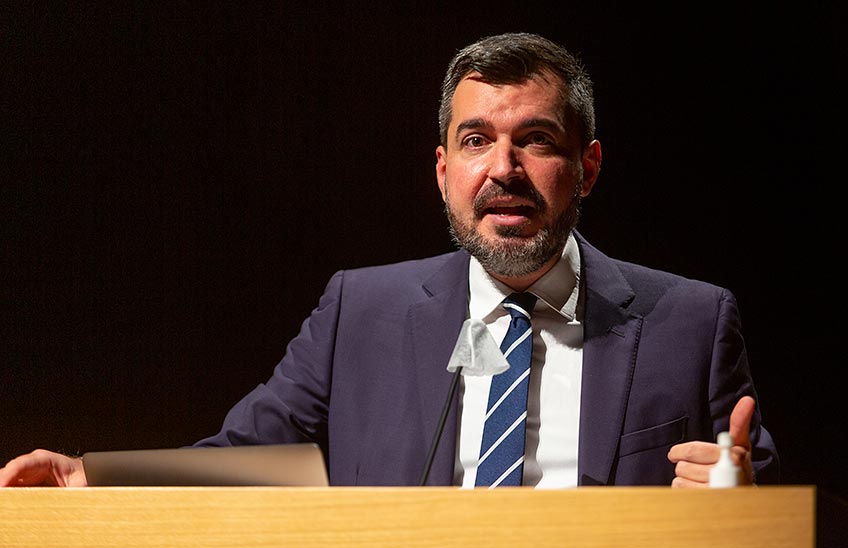Concludes the lecture series that the Friends of the Prado Museum Foundation organizes at the University in partnership with the School of Philosophy y Letras
David García Cueto, Head of department of Italian and French Painting until 1800 at the Prado Museum, presented the figure of Sandro Botticelli.

PhotoManuelCastells/David García Cueto
23 | 02 | 2022
The lecture series organised by the Friends of the Museo del Prado Foundation in Pamplona, partnership with the School of Philosophy and Letters of the University of Navarra, came to an end on Wednesday 16. More than 300 people attended quotation in each of the four sessions in which experts from the national art gallery dealt with the figure and work of artists belonging to the Renaissance, a period also known as the Spring of Art. David García Cueto, Head of the Museo del Prado's Italian and French Painting up to 1800 department , introduced the audience to the artistic production of Sandro Botticelli, "an artist who, although he is well known, is worth revisiting and reconsidering in order to get a more precise idea of his work bequest".
Born into a modest family in 15th-century Florence, Botticelli - Barrilete, as one of his brothers was nicknamed - soon acquired a great mastery of drawing, after an initial period as a goldsmith's apprentice, as explained by speaker. "As was customary, he entrusted his training to an artist and in his first works we can see some of the characteristics of the painting of his master, Filippo Lippi". Thus, in a few years he underwent a great evolution: "In his painting he shows signs of wanting to take a step towards modernity with respect to what was established in the Renaissance," said García Cueto. "He worked a lot on the changing intensity of the colours, another sign of mastery, as in the case of the Adoration of the Magi, for example, where he uses few colours but plays with tonalities". Another of the characteristics that speaker emphasised were the "sculptural airs" of his painting: "It is clear that in order to give it greater corporeality, Botticelli looked at sculptures and learned from their volumetry, overcoming a certain archaism in the composition of space".
Once Botticelli became an independent painter, he established his workshop in his native Florence and surrounded himself with journeymen and apprentices to execute commissions for churches, private houses and public buildings. As the expert explained, one of his most famous and sought-after paintings was the Madonna of the Magnificat in the Palazzo Pitri. "This subject of images was commissioned for the wealthy Florentine houses. To meet this great demand, several categories were established: works made entirely by him; those made by him and his assistants; and those painted solely by his apprentices". In this sense, he explained how the technique of sewing patterns was applied to trace the master lines and copy the works, such as the one preserved in The Morgan Library in New York. However, "they were not always an exact copy, but were based on an idea for inspiration, and this was what differentiated him from his great competitor in the Florentine market, Pietro Perugino, Raphael's master, who repeated the same thing, saturating the market with copies". "Botticelli worked much harder to avoid the repetitiveness that came out of his workshop and in this sense he was more intelligent," he said.
In his exhibition, García Cueto also highlighted the artist's mastery in extracting the essence of the individuals he portrayed throughout his career degree program: "He was an excellent portraitist. Although he produced a relatively small number of portraits, issue , they are relevant enough to be remembered". With 100% confirmed authorship, only eight or nine have survived, he explained. His skill grew with his fame, which was consolidated when he was summoned to Rome by Pope Sixtus IV, "one of the greatest acknowledgements an artist could have", to decorate the Sistine Chapel with frescoes. Thus, the speaker showed the three scenes painted by the painter, who took advantage of his stay in Rome to study the buildings that remain: "He had a great ability to focus on the ancient and this period was a great opportunity for him".
Although most of Botticelli's output focused on religious themes - around 70% - "the most singular and famous works owed to him are mythological representations imbued with the philosophical thinking characteristic of the Florentine cultural elite of the time". García Cueto discussed some of them, such as The Spring, "whose true meaning has so far been impossible to unravel", or The Birth of Venus, "in which lies the visual interpretation of a very famous poem of the time". Before concluding, the speaker stated that "Botticelli continues to be an individual who fascinates, who captivates and who opens up unsuspected paths of artistic proposals".
David García Cueto holds a PhD in Art History from the University of Granada, where he has taught at teaching since 2009. He is also visiting professor at the universities of Ottawa, Bologna, Geneva and Rome, as well as at the Collège de France. In 2020 he joined the Museo del Prado as Head of department of Italian and French Painting up to 1800. programs of study His programs of study focuses, among other subjects, on artistic relations between Spain and Italy in the 17th century, on art and diplomacy in the Modern Age and on Spanish art in the Golden Age, having published numerous books on the subject, including the books Claudio Coello, pintor (1642-1693) (2016) and Seicento bolognese y Siglo de Oro español. El arte, la época, los protagonistas (2006).
Chronicle of the first session: In the beginning was Giotto.An introduction to Renaissance art. 26th January
Chronicle of the second session: Rogier van der Weyden, pictore nobilissimo. 2 February
Chronicle of the third session: The sons of Leonardo and Laocoonte.From the Hernandos to Alonso Berruguete. 9 February.
